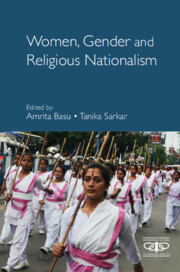Book contents
- Frontmatter
- Dedication
- Contents
- List of Abbreviations
- Introduction: Women of Hindu Rashtra
- Part I Changing Modalities of Hindu Nationalist Organizing
- Part II Gendered Techniques of Mobilization: The Sangh and the Samiti
- Part III Cultivating Women’s Militancy: The Vishva Hindu Parishad
- Part IV Refashioning Gender and Sexuality
- Part V Alternative Activist Responses to the Hindu Right
- Glossary
- About the Contributors
- Index
2 - Track Changes: Women and the BJP from the 1990s to the 2010s
Published online by Cambridge University Press: 12 August 2022
- Frontmatter
- Dedication
- Contents
- List of Abbreviations
- Introduction: Women of Hindu Rashtra
- Part I Changing Modalities of Hindu Nationalist Organizing
- Part II Gendered Techniques of Mobilization: The Sangh and the Samiti
- Part III Cultivating Women’s Militancy: The Vishva Hindu Parishad
- Part IV Refashioning Gender and Sexuality
- Part V Alternative Activist Responses to the Hindu Right
- Glossary
- About the Contributors
- Index
Summary
Introduction
Women and gender issues have played a central role in the rise of Hindu nationalism to political power through its political party – the Bharatiya Janata Party (Indian People's Party, henceforth BJP). But the BJP, as a religious nationalist political party and the political wing of the Sangh Parivar, faces a tension between its gender ideology – rooted in religion and nationalism, emphasizing the place of women in the home and the private sphere – and its need, as a political party in an established electoral democracy, to draw out the support of women as voters and half the electorate. How has the BJP resolved this tension over time as it evolved from a rising party striving for national presence to the predominant political formation in Indian politics?
To answer this question, I compare the role of women in the BJP in two critical time periods: its emergent phase in the 1980s and the early 1990s, and around the time of the 2014 election, as the party sought and achieved a return to power. I find that over this time period, the party moved from mobilizing women into street politics in the 1980s–1990s to incorporating them, in more routine and institutionalized ways, into its governance structures and electoral activities in the 2010s. Women leaders of the party shifted from being just a few women without significant family responsibilities (ascetic renunciants or widows) to being included at multiple levels of the party (national, state and local) in larger numbers who balanced family responsibilities and political work through the trope of ‘family support’. This shift in the role of women in the party reflected the greater professionalization and institutionalization of the party in the latter period, as it evolved from a party striving for power to one that was positioning itself to recapture it.
I carry out this comparison using two interrelated and gendered lenses: my research on the BJP and my fieldwork across both time periods – first in 1993–1994, for my dissertation research, and again from 2013 to 2016 as part of the field research for my forthcoming book. My primary analytical focus is on the BJP as a political party, with the understanding that the members and organizations of Hindu nationalism work hand in glove and are difficult to separate out in actual practice.
- Type
- Chapter
- Information
- Women, Gender and Religious Nationalism , pp. 52 - 74Publisher: Cambridge University PressPrint publication year: 2022
- 1
- Cited by



